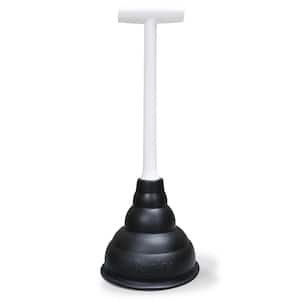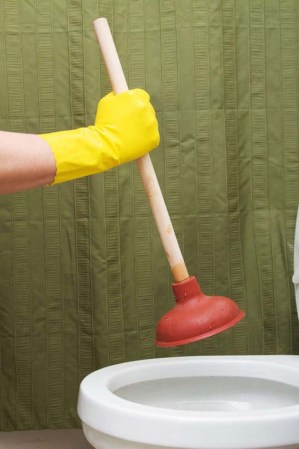Discover Plunger and Drain Cleaners Methods: Expert Guidance
CallAre you currently hunting for answers concerning How To Use Your Toilet Plunger Correctly in 5 Easy Steps?

Intro
Appropriate maintenance of house drains is essential for protecting against blockages and ensuring smooth water circulation. One of the secret devices in every house owner's toolkit is the plunger, together with numerous drain cleansers designed to deal with persistent clogs properly. This post explores just how to use bettors and drain cleaners properly to keep your drains pipes flowing easily.
Area 1: Understanding Bettors
Sorts of Plungers
There are a number of sorts of bettors available, each created for various types of drains and blocks. One of the most usual types include cup bettors, flange bettors, and accordion plungers.
Just How Plungers Job
Plungers work with the concept of developing stress and suction to dislodge obstructions. When effectively applied over a drainpipe, they develop a vacuum that can pull out particles or separate obstructions.
Selecting the Right Plunger
Picking the ideal plunger relies on the kind of drain and the nature of the obstruction. Cup bettors are excellent for sinks and tubs, while flange bettors are better matched for bathrooms as a result of their style.
Usual Errors with Bettors
Avoiding these blunders ensures reliable plunging: improper seal around the drain, not enough force, and not clearing bordering particles.
Section 2: Making Use Of Plungers Successfully
Preparation
Prior to plunging, make sure the plunger covers the drainpipe completely and creates a tight seal. Clear any type of noticeable debris around the drainpipe opening.
Technique
Begin with mild plunging movements to construct suction. Increase stress progressively, using a consistent rhythm. Repeat as necessary until the drain gets rid of.
Troubleshooting Tips
If plunging doesn't function, attempt readjusting the seal, using petroleum jelly for a better seal, or utilizing a different kind of bettor.
Section 3: Comprehending Drainpipe Cleaners
Kinds Of Drainpipe Cleansers
Drain cleaners can be chemical or chemical. Chemical cleaners use strong chemicals to dissolve clogs, while enzymatic cleansers make use of all-natural enzymes to break down raw material.
Exactly How Drain Cleansers Work
Chemical cleaners respond with obstructions to liquify them, while chemical cleaners break down organic products like hair and oil without hurting pipes.
Safety and security Factors to consider
Always wear handwear covers and eye security when using chemical drainpipe cleaners. Ensure ample ventilation and follow supplier directions carefully.
Eco-Friendly Alternatives
Take into consideration using vinegar and cooking soda or enzyme-based cleansers for environmentally friendly alternatives that are safer for pipelines and the environment.
Section 4: Making Use Of Drain Cleansers Properly
Application Techniques
Put chemical cleansers straight into the drain opening. Permit them to benefit the recommended time before purging with warm water. Chemical cleansers should sit overnight.
Safety measures
Stay clear of blending various sorts of cleansers, as this can produce toxic fumes. Never use chemical cleaners together with a plunger, as splashing can happen.
Dealing With Stubborn Clogs
For persistent obstructions, consider using a pipes snake or calling a professional plumbing technician to prevent damages to pipelines.
Final thought
Finally, understanding exactly how to make use of plungers and drain cleansers properly is vital for keeping healthy and balanced pipes systems. By choosing the right tools and techniques, house owners can deal with small obstructions and protect against significant pipes issues down the line.
How To Properly Use A Plumbing Snake To Clear Drains
When any drain clogs in our home arise, we tend to gravitate toward the plunger and little else. In cases where the plunger and its vacuum-created pressure are not able to clear clogs, many immediately move to harmful chemicals or simply call their plumber to fix the issue.
we’re happy to help with all drain cleaning needs and concerns. This includes informing you on a few other home remedies you may have at your disposal for minor to moderate clogs, one of which is the use of a plumbing snake. Many people have never used one of these before – let’s go over the steps to take when your drain clogs and you have a plumbing snake available.
Attempt Plunger Use
The first step here, as we noted above, should indeed be to grab your plunger when you notice a drain clog and attempt to resolve it this way. If you’re unsure how to use a particular type of plunger, our plumbers can answer any questions you have. If this doesn’t do the trick, however, you move on to the snake.
Locate And Prepare Snake
A plumbing snake is a metal or plastic device that’s generally about a quarter of an inch thick. It’s design with significant extensions, meant to reach down into your clogged drain and push the clog out. Snakes also contain drain augers that will latch onto and push stubborn blockages.
If your plunger doesn’t clear a clog, locate your snake and bring it to the drain in question. We also recommend keeping a bucket nearby to collect the clog once you pull it out, plus we’d advise wearing goggles and possibly protective gloves.
Feed Snake
Once you’re ready to go, feed the snake slowly down the drain, using the crank device it comes with to keep it moving until it finds the clog. Once this happens, much of the clog will be latched onto the coil so you can pull it out, while the rest will simply break up and flow downward.
Detach Debris
Remove the snake slowly from the drain, and once you’ve done so, pick off any debris that’s stuck to the coil. This is another area where wearing gloves is a must.
Flush Drain
Finally, take a few minutes to ensure the snake has done its job correctly. If you’ve been using it on a toilet, flush the toilet a couple times and make sure everything flows well. If you’ve used it on a different drain, flush it with some room temperature water.
https://www.mybuddytheplumber.com/blog/how-to-properly-use-a-plumbing-snake-to-clear-drains/

Application Techniques
Put chemical cleansers straight into the drain opening. Permit them to benefit the recommended time before purging with warm water. Chemical cleansers should sit overnight.
Safety measures
Stay clear of blending various sorts of cleansers, as this can produce toxic fumes. Never use chemical cleaners together with a plunger, as splashing can happen.
Dealing With Stubborn Clogs
For persistent obstructions, consider using a pipes snake or calling a professional plumbing technician to prevent damages to pipelines.
Final thought
Finally, understanding exactly how to make use of plungers and drain cleansers properly is vital for keeping healthy and balanced pipes systems. By choosing the right tools and techniques, house owners can deal with small obstructions and protect against significant pipes issues down the line.
How To Properly Use A Plumbing Snake To Clear Drains
When any drain clogs in our home arise, we tend to gravitate toward the plunger and little else. In cases where the plunger and its vacuum-created pressure are not able to clear clogs, many immediately move to harmful chemicals or simply call their plumber to fix the issue.
we’re happy to help with all drain cleaning needs and concerns. This includes informing you on a few other home remedies you may have at your disposal for minor to moderate clogs, one of which is the use of a plumbing snake. Many people have never used one of these before – let’s go over the steps to take when your drain clogs and you have a plumbing snake available.
Attempt Plunger Use
The first step here, as we noted above, should indeed be to grab your plunger when you notice a drain clog and attempt to resolve it this way. If you’re unsure how to use a particular type of plunger, our plumbers can answer any questions you have. If this doesn’t do the trick, however, you move on to the snake.
Locate And Prepare Snake
A plumbing snake is a metal or plastic device that’s generally about a quarter of an inch thick. It’s design with significant extensions, meant to reach down into your clogged drain and push the clog out. Snakes also contain drain augers that will latch onto and push stubborn blockages.
If your plunger doesn’t clear a clog, locate your snake and bring it to the drain in question. We also recommend keeping a bucket nearby to collect the clog once you pull it out, plus we’d advise wearing goggles and possibly protective gloves.
Feed Snake
Once you’re ready to go, feed the snake slowly down the drain, using the crank device it comes with to keep it moving until it finds the clog. Once this happens, much of the clog will be latched onto the coil so you can pull it out, while the rest will simply break up and flow downward.
Detach Debris
Remove the snake slowly from the drain, and once you’ve done so, pick off any debris that’s stuck to the coil. This is another area where wearing gloves is a must.
Flush Drain
Finally, take a few minutes to ensure the snake has done its job correctly. If you’ve been using it on a toilet, flush the toilet a couple times and make sure everything flows well. If you’ve used it on a different drain, flush it with some room temperature water.
https://www.mybuddytheplumber.com/blog/how-to-properly-use-a-plumbing-snake-to-clear-drains/

We were brought to that write-up about How to Use a Plunger to Unclog a Toilet or Drain through a good friend on our other web property. Sharing is caring. Helping people is fun. We thank you for reading our article about Here's How to Correctly Use a Toilet Plunger.
See Availability